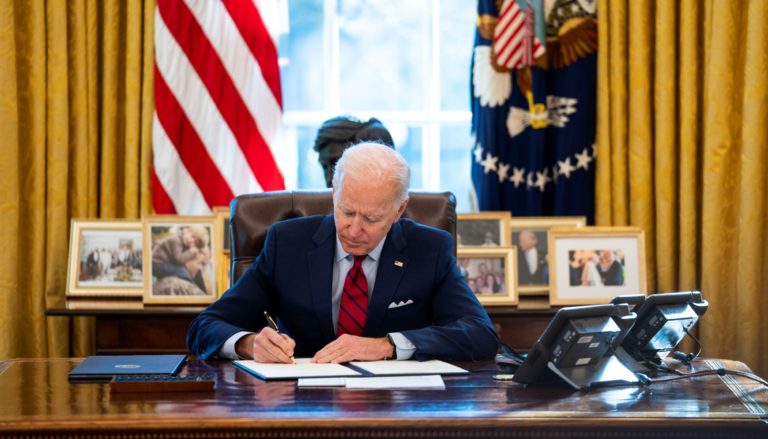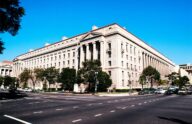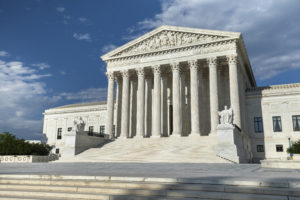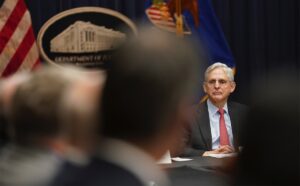The Detroit News: Supreme Court must curb president’s expansive power

Arbitrary government has no place in our constitutional order. Yet many of today’s most significant federal policies reflect blatant abuses of presidential discretion.
To cite the latest example, President Biden continues to maintain an indefinite state of “national emergency” for the COVID-19 pandemic, even though he declared last September that “the pandemic is over.” Why? Because an ongoing emergency is a key cog of the administration’s cockamamie legal justification to unilaterally cancel up to $519 billion in student debt.
Former President Trump, of course, abused this same authority when he declared a bogus “national emergency” for immigration in early 2019, even though apprehensions at the southern border were at historic lows. Why? Because he had just failed to make a deal with lawmakers, and an emergency declaration allowed him to skirt Congress’s power of the purse and thereby conjure nearly $4 billion to (partially) build a border wall.
What is going on here? Our polarized Capitol Hill shoulders some of the responsibility. Half of Congress loses interest in executive overreach whenever “their guy” occupies the White House.
But the lion’s share of the blame is borne by the judicial branch of government. We look to courts to protect individual liberties from arbitrary restraints. As Justice Neil Gorsuch recently averred, a court’s “duty is to the rule of law and the search for truth.” The judiciary has failed this duty in allowing presidents to empower themselves by declaring “emergencies” in name only. Simply put, these arbitrary policies—among others—are emerging from a major loophole in our rule of law.
Most of the time, Congress grants regulatory power to subject‐specific agencies, such as the Environmental Protection Agency and the Department of Labor. When an administrative agency’s regulation is the subject of litigation, courts perform reasonableness review to prevent arbitrary action.
Sometimes, however, Congress grants regulatory authority directly to the president, such as the “emergency” power described above. But when presidents regulate, courts do not perform reasonableness review. And because courts don’t check for reasonableness, presidents are permitted to be unreasonable when they make policy.
The courts’ hands-off approach to presidential policymaking is the result of two misguided Supreme Court decisions from the early 1990s, Massachusetts v. Franklin and Dalton v. Spector. The result of these cases is that the president’s regulatory authority is effectively immune from meaningful judicial oversight.
Of course, there can be no meaningful limits on executive power if presidents are allowed unfettered discretion to interpret the extent of their own power. In this context, presidents are effectively above the law, which is antithetical to constitutional government.
In Federalist 48, James Madison famously observed that “power is of an encroaching nature,” and so it is here. By insulating the president from reasonableness review, the Supreme Court lifted an important check on executive authority. Since the Court adopted its hands‐off approach, presidents have pushed the envelope of their statutory powers through expansive—and often implausible—interpretations of their own statutory authority.
The president’s “national emergency” authority, discussed above, is one such example. Another example is the ongoing trade war started by former President Trump, and since continued by President Biden, based on “national security” tariffs under the Trade Expansion Act. Although the law doesn’t define national security, presidents historically adopted a common‐sense interpretation that focused on how imports affected the needs of the military. Trump and Biden, however, abandoned this approach for an expansive definition that includes considerations “beyond those necessary to satisfy national defense requirements,” such as “the general security and welfare of certain industries.” The result was tariffs that bizarrely applied to our closest military allies in NATO. These trade taxes resulted in roughly $51 billion of annual consumer costs (and counting).
Still another example is the ongoing abuse of presidential monument declarations. To regulate public lands and waters, Congress set up complex regimes designed to incorporate feedback. However, presidents can achieve the same result simply with the swipe of a pen by designating monuments under the Antiquities Act. That law was enacted in 1906 to protect archaeological sites and artifacts from vandalism, but modern presidents now draw vast borders on a map, label everything there to be a “monument,” and then regulate as they see fit. If a regulatory agency attempted this, it would be laughed out of court.
Alas, the problem is getting worse. Presidential exercises of statutory power create their own political momentum. Because the Founders feared an overbearing government, the Constitution makes it hard for Congress to pass laws. Executive lawmaking, by contrast, requires no more than the swipe of the president’s pen. The comparative ease of executive action has not been lost on special interests across the political spectrum, who now focus much of their lobbying energies on the president. Lawmakers, even congressional leaders, now commonly call for executive lawmaking; Senate Majority Leader Chuck Schumer, for example, has urged Biden to “call a climate emergency,” because “he could do many, many things under the emergency powers of the president that he can do without legislation.”
These related dynamics serve to spur runaway executive power. Presidents break norms to make unilateral law, which engenders political demand for more unilateral action by the lawmaker‐in‐chief. An unfortunate side effect is the exacerbation of political divisiveness, as the presidency has become the ultimate prize in the ongoing contest between the two parties.
Still, the news isn’t all bad. Recently, the Supreme Court signaled interest in upsetting the status quo. In a 2021 statement in a case brought by Pacific Legal Foundation that challenged President Obama’s designation of a 3.2-million-acre ocean monument, Chief Justice John Roberts said he was on the lookout for a case that “might guide our review of the President’s actions” under the Antiquities Act. For all intents and purposes, Roberts called for ideas on how to conduct substantive review of the president’s powers.
In a recent paper published by the Cato Institute, Reining in the Unreasonable Executive, I try to answer Roberts’ call by proposing a framework for courts to conduct reasonableness review of the president’s regulatory powers. The proposed framework relies on common-sense considerations, such as whether the president’s action is utterly unprecedented, or if it is directly belied by the president’s own statements.
Yet the most important factor is simply whether the president’s interpretation of his own authority admits no limits. Under the Antiquities Act, for example, presidents are reasoning that ecosystems, per se, meet the definitions of a monument. But if ecosystems are “monuments,” then monuments are literally everywhere on earth, as there are ecosystems everywhere on earth. Similarly, in justifying their trade war, for example, Presidents Trump and Biden claim that the nation’s economic well‐being supports military spending, so economic well‐being is a matter of “national security.”
Under the Constitution, no person can be above the law, even the president. No individual should be left at the mercy of unreviewable abuses of discretion backed by the state’s power. “The supremacy of law demands that there shall be opportunity to have some court decide whether an erroneous rule of law was applied,” in the words of Justice Louis D. Brandeis. At present, however, the “supremacy of law” vanishes whenever the president regulates. Instead, the law becomes whatever the president says it is.
Enough is enough. The Supreme Court must end the president’s leeway to be unreasonable.
This op-ed was originally published in The Detroit News on November 25, 2022.








